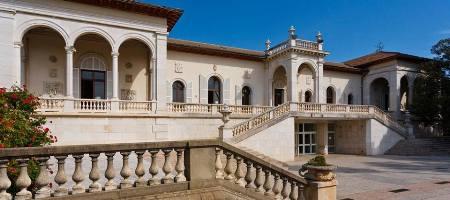History
In 1875 the businessman Michel Louis Ormond, Swiss cigars producer who loved history and arts, became Villa Rambaldi’s owner in Sanremo; he bought it for his wife Marie Marguerite Rènet, because she thrived in the mild climate of the Riviera. When on 25th February 1887 a violent earthquake in the Western Ligurian Riviera severely damaged the property, the Ormond Family decided to build a new building: after two years, Villa Ormond was born, designed by the Swiss architect Emile Réverdin, who was already the author of many villas of the high society and the Opera House in Geneva.
The house, in Classic style with some traits of the Tuscan Renaissance, extends in length and has only one raised floor on a large square and a massive staircase; both are connected with avenues and the English Garden with a view on the sea.
The building is surrounded by a large terrace with lodges at each corner and a pronaos in front of the entrance; inside you can see large polychrome coffered ceilings and in the salon a fireplace coming from the Castle of Doria in the village of Dolceacqua.
The luxurious building was made in stones from a cave near Toulon, while glasses are Saint Gobain’s; for the decoration two Swiss painters were called and the upholsteries were woven in Genoa and Lyon. It hosted various famous guests like the Princes of Prussia, Empress Elisabeth of Austria and the Duke of Aosta. At the death of the owners, it was bought by the Municipality of Sanremo in 1930.
Thanks to Pietro Agosti, the park was opened to the public and a big fountain and the pavilion for the expositions were added. Nowadays it’s the heritage of all the town and is used for ceremonies, conferences and meetings; the best botanicals gardeners, agronomists and landscapists planted a great collection of palms, trees and shrubs coming from all continents.
Park
In the park, split in two gardens by Aurelia street and the old railroad, there are palms, cedars, olive groves and an Italian garden. Nowadays, you can see important plants like two groups of Phoenix palms, considered the most majestic of Europe. In the park of Villa Ormond, it’s possible to admire the “Japanese Garden”, realized in 2011 by Kazuo Makioka, inspired by Zen philosophy, thanks to the twin city Atami. In the gardens there are two statues: the first one, in memory of the Mexican Ignacio Altamirano, poet, historian and statesman who died in Sanremo in 1983; the second one in memory of Nicola I, king of Montenegro,( father of the Italian Queen Elena), buried in the crypt of the Russian Church in 1921.
Today, Villa Ormond became a place of temporary exhibitions, while another part hosts the International Institute of Human Rights, organization founded in 1970 and recognized by NU, that promoted the safeguard of human rights with particular attention to refugees from armed conflicts territories.

